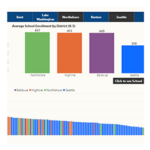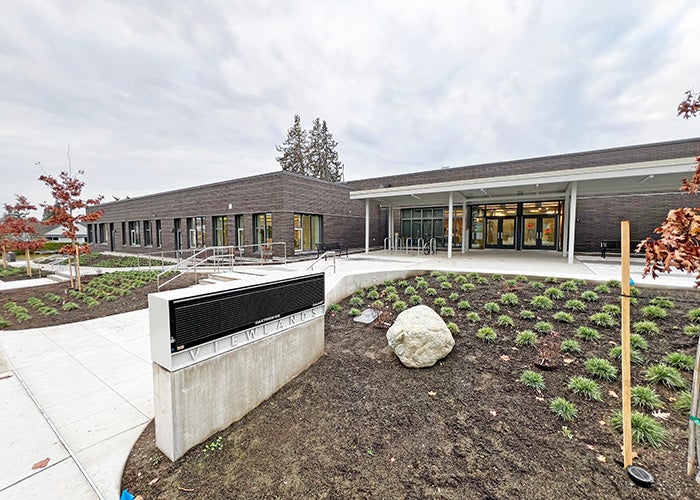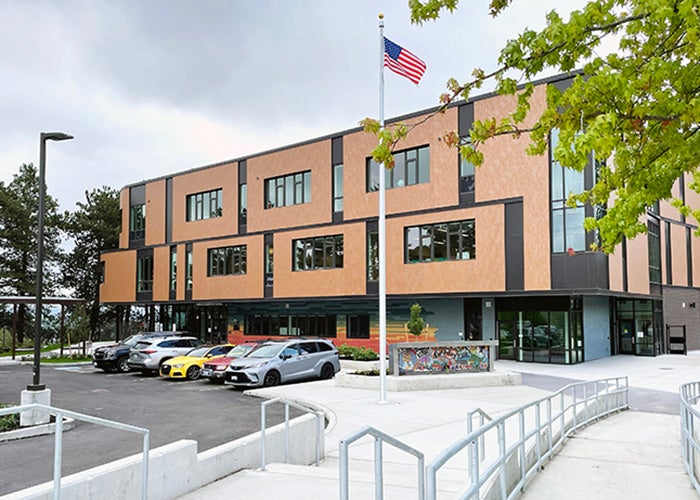Criteria
Well-Resourced Schools Planning Criteria, Data, and Equity
Elementary Student Counts in Neighbor Districts

See how school sizes compare in school districts in the greater Puget Sound region.
Defining Equitable Outcomes
Defining Equitable Outcomes for the System of Well-Resourced Schools
What would it look like if this initiative ensured educational and racial equity for every student?
The current system, which provides most resources based on enrollment, gives students uneven access to core services including art and music, counselors/social workers and support staff.
These services were key themes that community members identified as essential and beloved parts of their child’s education in fall 2023 Well-Resourced Schools engagement.

Students of color, especially Black students, are disproportionately served in schools that are too small (< 350 students) for sustainable allocation of the resources and services they need and deserve. With declining enrollment and a structural budget deficit these gaps in core student services will only get worse without action.
Seattle Public School’s vision for a system of schools will:
- Achieve strategic plan goals with inclusive learning and support for all, most students served at their neighborhood school.
- Support special education and inclusionary practices, special education intensive services available in EVERY elementary school.
- Multilingual learners supported in their neighborhood school.
- Expand access to advanced learning by providing service in all elementary schools.
- Multiple teachers per grade level with aligned planning/ collaboration time supports flexible grouping, inclusive learning and advanced learning opportunities.
- Students served in modern, well-maintained buildings that support our educational vision.
- Support projected enrollment and regional student population density by effectively using building capacity and regional capacity.
- Allocate resources effectively and sustainably to achieve an equitable system
A racially equitable outcome will do a better job of fulfilling Policy 2200, equitable access to programs and services:
- Place programs or services in support of district-wide academic goals;
- Place programs or services equitably across the district;
- Place programs or services where students reside;
- Place programs or services in accordance with the rules of the current student assignment plan, and as appropriate, equitably across each middle school feeder region;
- Engage stakeholders in a timely and publicly visible manner by informing, involving, and/or consulting with them as appropriate, and consider their input in the decision-making process when feasible;
- Utilize physical space resources effectively to assure that instructional and program space needs are equitably met across the district;
- Ensure that fiscal resources are taken into consideration, including analyzing current and future fiscal impacts; and
- Analyze the impact of any decision before it is made, by using data, research and best practice
To achieve this vision systemwide, many students and families will be impacted by school closures and/or boundary changes, including students of color. However, a racially equitable outcome will not disproportionately impact students of color furthest from educational justice.
Educational Access and Racial Equity
- Advanced Learning Services: We are expanding access to advanced learning services and making them available in all neighborhood schools.
- Multilingual Learners Services: Multilingual services are available to students in all schools.
- Foster Care and McKinney-Vento Services: Student placement decision for students in foster care and students who are experiencing homelessness will be guided by Foster Care and McKinney-Vento guidelines.
- Special Education IEP Intensive Services: SPS will ensure that all special education services and the full continuum of pathways will be available to all students who qualify. For many students, the services and pathways will be available at their neighborhood school. If a student is assigned to a pathway not available at their neighborhood school, they will be assigned to a school that has the appropriate pathway as close as possible to their residence. A parent or guardian can request an IEP meeting at any time to discuss their student’s services.
Please note: Dual Language Immersion (DLI) Program Model: We recognize the value of DLI programs in building on the brilliance of our multilingual learners and plan to expand access to these programs in our neighborhood schools.
Special Education
Current State
Many schools are not able to offer special education intensive services.
Examples:
- We need 54 extended resource classrooms.
- Maintaining 73 schools means 19 schools don’t offer extended resource services.
66% of students with Intensive IEP Services cannot attend their neighborhood school.
Educational Access
Current State
Students of color, especially Black students, are disproportionately served in schools that are too small to offer the resources and services they need and deserve.
54% of all K-5 SPS students attend a school smaller than 350.
Option Schools
Current State
Option schools historically provided capacity relief for overcrowded schools; today, they draw enrollment and resources from neighborhood schools.
Both option and neighborhood schools develop unique instructional models to serve their student and communities.
Option schools disproportionately serve students who have traditionally had additional access to additional educational resources.
Most option schools serve a smaller proportion of students who are eligible for free and reduced school meals compared to the demographics of their geographical zone.
17.6% of K-5 students attend option schools.


Criteria for Well-Resourced Schools

Building Condition Score: Examines the school building to determine if the physical facility safe and healthy. Example: Roof is 10 years old; School has air-conditioning.
Learning Environment Score: Examines the school building to determine if the facility design supports learning. Example: Open concept design is challenging for auditory processing.
Well-Resourced Capacity (building): Examines the school building to determine if the facility can hold 400+ students including intentional space for intensive IEP services and preschool classrooms.
Well-Resourced Capacity (system): Examines if as a whole, SPS is using our building capacity effectively.
Regional Distribution: Examines if our district has the right number of schools for the number of students in the area with space for growth.
Building Condition Score: Shape and Condition
Each building has rating from 0 to 100; a higher rating indicates better building condition
Score includes multiple systems:
- Is the roof in good condition?
- Is the HVAC system updated?
- What will need to replaced or updated?
| Score | Condition |
| 100 | Excellent or New |
| 90 | Good |
| 62 | Fair |
| 30 | Poor |
| 0 | Unsatisfactory |
Learning Environment Score
An assessment of the functional ability of facilities to support our educational programs including
Spaces: Adequate size and quantity
Configuration: Educational priorities, program flexibility, community connections
Environment: Aesthetics, safety, responsive to human needs
| Score | Condition |
| 1.0-1.99 | Excellent: meets all SPS standards |
| 2.0-2.99 | Good: meets most SPS standards |
| 3.0-3.99 | Fair: Below current SPS standards with some criteria lacking |
| 4.0-4.99 | Poor: Far below SPS standards with many criteria lacking |
| 5 | Unsuitable: Severely lacking support for SPS standards |

Future Capacity Considerations
We’re calculating school capacity a little differently because we want our schools to reflect our educational design vision. This new capacity will mean a shift in how some schools are using their buildings; it centers building use on student needs, student learning and our academic vision.
Well-resourced schools serve preschool and special education intensive students
- 3 full-size classrooms dedicated for special education intensive services
- 2 full-size classrooms for preschool
Inclusive learning means students spend most of their instructional time in general education classrooms
- Full-size classrooms are prioritized for core instruction, including art and music
- Resource, Multilingual and SLP/OT/PT services will use smaller spaces
General education classroom capacity is calculated at 26 students for K-3 and 28 for 4th-5th
- Is consistent with class size limits in the collective bargaining agreement
Well-Resourced Schools Capacity
To maximize our building capacity to create well-resourced schools, we have reconsidered how we calculate building capacity. Well-resourced capacity ensures that we can create well-resourced schools within our current building portfolio while planning for declining enrollment.
Well-resourced capacity definition is based in the 2016 elementary educational specifications with these changes:
- Standard classrooms (for general education and special education intensive services) are any classrooms greater than approximately 700 sq. ft
- General education classroom capacity is 26 students for K-3 and 28 for 4-5 (CBA)
- Resource, multilingual services and SLP will use spaces smaller than 700 sq. ft
- Each building will have 3 full size special education intensive services classrooms
- Portables aren’t included in capacity with some narrow exceptions (portables in good condition, long term plans for expansion at the site)
- Room use prioritization: 3 special education intensive services and 2 preschool, core instruction classrooms (including music, art and PE), space for before/after care and partners as space allows

Resources and Report Links
- Enrollment Planning projections forecasts of future enrollment
- Enrollment Planning reports current and past enrollment
- Enrollment Planning maps geographical analysis
- School Board Guiding Principles for BEX VI Capital Levy Planning
- School Building Educational Specifications
- School Building Conditions: Facilities Master Plan
- Budget Information: Funding Sources for Schools
